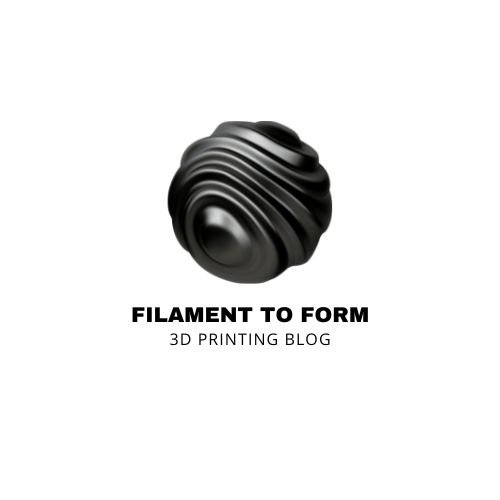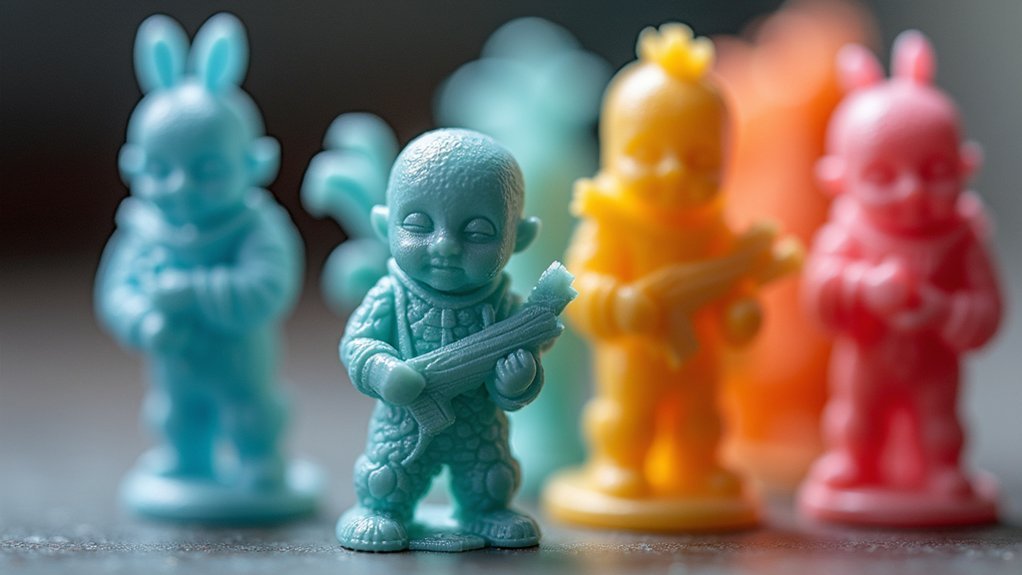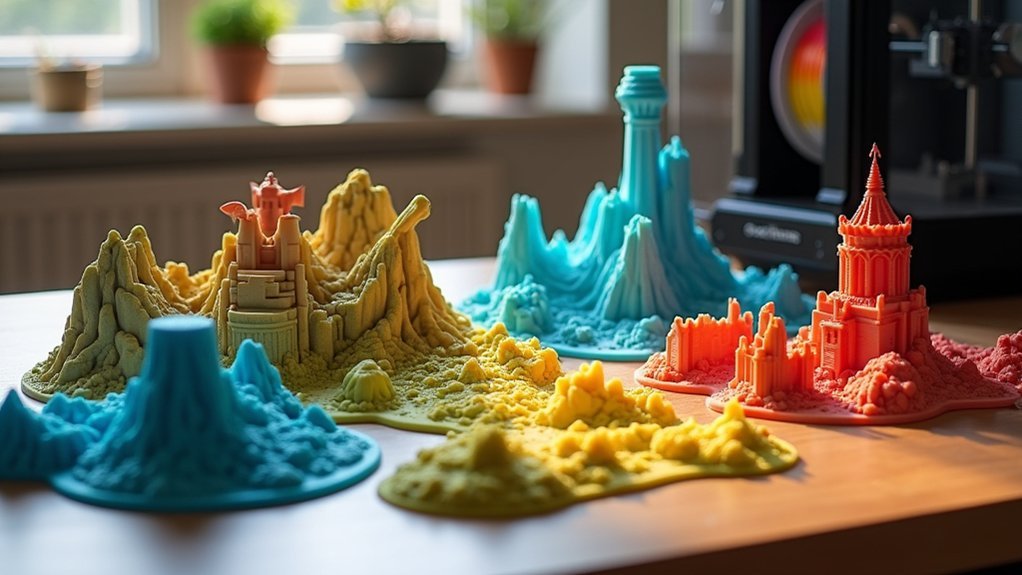You’ve probably experienced that sinking feeling when your carefully planned 3D print warps, lifts, or fails completely due to poor bed adhesion. The right textured print surface can transform your printing experience from frustrating failures to consistent successes. While smooth surfaces might seem adequate, textured options provide the mechanical grip that keeps your prints anchored throughout the entire process. Three specific solutions stand out for their proven ability to solve adhesion problems across different printer types and materials.
Fula-Flex Textured PEI PRO Build Plate Flex Sheet for Creality K1 Max
If you’re struggling with print failures on your Creality K1 Max, the Fula-Flex Textured PEI PRO Build Plate Flex Sheet delivers 40% better adhesion than standard PEI surfaces while eliminating 99% of adhesion-related printing problems. You’ll get strong adhesion for PLA, ABS, PETG, TPU, Nylon, and PC materials without needing glue sticks. The magnetic sheet provides excellent grip and removes prints easily—just flex the sheet instead of scraping. While it performs best with PLA and ABS, PETG may damage the black coating. Users consistently report superior performance compared to off-brand alternatives and appreciate the included one-year warranty.
Best For: Creality K1 Max users experiencing frequent print failures due to poor bed adhesion who want a reliable, easy-to-use build surface that works with multiple filament types without requiring additional adhesives.
Pros:
- Delivers 40% better adhesion than standard PEI and eliminates 99% of adhesion-related print failures
- Works with multiple materials (PLA, ABS, PETG, TPU, Nylon, PC) and removes prints easily by flexing the sheet
- Includes one-year warranty with positive customer support experiences and consistent performance over time
Cons:
- PETG printing may damage the black coating on the surface
- Black texture may transfer onto lighter-colored prints during printing
- Alignment pin cutouts may need to be wider for optimal fit on some printers
235×235 Double Sided Textured PEI Magnetic Bottom Sheet for Ender-3 3D Printers
The HICTOP 235x235mm double-sided textured PEI magnetic bottom sheet transforms your Ender-3 series printer into a reliable adhesion powerhouse, making it the ideal upgrade for makers who’ve struggled with warped prints and inconsistent bed adhesion. You’ll appreciate the simple installation process—just stick the magnetic base onto your heated bed and place the flexible steel platform on top. Both textured PEI surfaces deliver excellent adhesion at 60℃ for most materials and 80-85℃ for PETG, eliminating the need for glue or tools. When your prints finish, they’ll release easily as the bed cools, and gentle flexing helps remove stubborn pieces.
Best For: Ender-3 series 3D printer owners who want to eliminate bed adhesion issues and warped prints with a simple, tool-free upgrade that works reliably across multiple printing materials.
Pros:
- Double-sided textured PEI surface provides excellent adhesion without glue or tools and allows easy print removal when cooled
- Simple magnetic installation system with flexible steel platform that can be removed for easy print extraction
- Compatible with multiple Ender-3 variants and handles various materials including PETG with appropriate temperature settings
Cons:
- Limited maximum bed temperature of 130℃ may restrict compatibility with high-temperature printing materials
- Specific size (235x235mm) limits compatibility to only certain 3D printer models in the Ender series
- Magnetic system adds thickness to the bed setup which may require bed leveling adjustments and reduce overall build height
Oxdigi Dark Walnut Contact Paper – Self-Adhesive Peel and Stick Wallpaper
Among self-adhesive wallpaper options, Oxdigi’s Dark Walnut Contact Paper stands out for homeowners and renters seeking a premium wood-textured finish that won’t compromise on durability. You’ll appreciate its 23.6 x 196-inch PVC construction that’s both waterproof and oil-proof, making it perfect for kitchens and bathrooms.
The peel-and-stick application couldn’t be simpler—just clean your surface first, use the grid lines for cutting, and apply slowly with a squeegee. You can transform cabinets, countertops, shelves, doors, and even appliances with this versatile material.
With 4.4 stars from over 4,400 customers, you’re getting proven quality that’s easy to maintain with just a damp cloth.
Best For: Homeowners and renters looking for an affordable, temporary way to update kitchens, bathrooms, and furniture with a realistic wood grain finish without permanent modifications.
Pros:
- Waterproof and oil-proof PVC material makes it ideal for high-moisture areas like kitchens and bathrooms
- Simple peel-and-stick installation with helpful grid lines for cutting and positioning
- Versatile application on multiple surfaces including cabinets, countertops, appliances, and furniture
Cons:
- Some users experience challenges with bubbles and stretching during application, requiring careful handling
- Corners and edges can be difficult to apply smoothly without practice
- May require patience and technique to achieve professional-looking results
Factors to Consider When Choosing Textured Print Surfaces for Better Adhesion
When you’re selecting a textured print surface, you’ll need to match the material compatibility with your specific filament types and guarantee the build plate dimensions fit your printer perfectly. You must also verify the surface can handle your printer’s operating temperatures while providing adequate magnetic base strength for secure attachment. Don’t overlook the surface texture depth, as it directly impacts how well your first layer adheres without making part removal too difficult.
Material Compatibility Requirements
Several critical factors determine whether a textured print surface will work effectively with your chosen 3D printing materials. Different filaments like PLA, ABS, PETG, TPU, Nylon, and PC each have unique adhesion requirements that you’ll need to match with compatible surface materials. For instance, PEI surfaces deliver up to 40% better adhesion than standard options, greatly reducing print failures across multiple material types.
You’ll also need to adjust your heated bed temperature based on material compatibility—60℃ works well for general printing, while PETG requires 80-85℃ for ideal adhesion. Consider the surface’s longevity with your specific materials, as some combinations maintain consistent performance while others may degrade over time, affecting your print quality and requiring earlier replacement.
Build Plate Dimensions
Beyond material compatibility, your build plate’s exact dimensions determine which textured surfaces will fit properly and deliver perfect adhesion. You’ll need to measure your printer’s build plate precisely since standard sizes vary greatly across different manufacturers and models. A mismatched surface won’t align correctly, creating gaps that compromise adhesion quality.
When you’re upgrading to larger build plates, you’ll face unique challenges maintaining consistent adhesion across the entire surface area. Specialized adhesion solutions become necessary to prevent warping and guarantee uniform contact. You should select textured surfaces specifically designed for your build plate dimensions, as these provide ideal contact area for your printed material. Proper sizing enhances the textured surface’s ability to grip your prints effectively throughout the entire printing process.
Temperature Resistance Limits
Understanding your print surface’s temperature resistance limits prevents costly damage and guarantees consistent adhesion performance across different filament types. You’ll want to maintain printing temperatures between 60℃ for general materials and 80-85℃ for PETG to achieve excellent adhesion on textured surfaces. Quality textured surfaces like PEI can handle maximum temperatures up to 130℃ without losing structural integrity, giving you flexibility with high-temperature filaments.
Consistent elevated temperatures prevent warping and adhesion failures during printing. However, you must allow prints to cool completely to room temperature before removal, as higher temperatures cause prints to stick more firmly to the surface. Following these temperature guidelines assures your textured surface’s longevity while maintaining ideal adhesion properties throughout countless printing sessions.
Magnetic Base Strength
A robust magnetic base forms the foundation of reliable 3D printing performance, directly impacting your print quality and surface longevity. You’ll need sufficient magnetic strength to prevent print shifts and failures during the printing process. A stronger magnetic base provides better grip, ensuring your print surface stays securely attached even when you’re applying force to remove prints.
Choose high-quality magnetic bases that’ll withstand repeated flexing without losing their adhesion properties, extending your print surface’s lifespan. Your magnetic base must be compatible with your specific build plate and handle thermal expansion during heating. Consider your typical print dimensions carefully – the magnetic base’s effectiveness depends on matching its strength to your print’s weight and size requirements.
Surface Texture Depth
Surface texture depth determines how well your prints will stick to the build plate, creating the mechanical interlocking necessary for reliable adhesion. You’ll find that shallow textures won’t provide enough grip, causing prints to lift or warp during printing. However, excessive depth creates uneven contact points that actually reduce adhesion quality.
You should look for moderate texture depths that balance surface roughness with consistent contact. PEI sheets excel at this optimization, providing ideal surface profiles for various filament types. Different materials require specific texture depths—what works for PLA might not suit PETG or ABS.
Research confirms that properly textured surfaces considerably reduce print failures and warping. You’ll achieve better results by matching your surface’s texture depth to your chosen filament’s bonding characteristics.
Removal Flexibility Features
Flexibility revolutionizes print removal by allowing you to bend textured sheets rather than scraping prints off rigid surfaces. Fula-Flex and HICTOP surfaces excel at this, letting you simply flex the sheet to detach prints without tools or risk of damage. This performance stays consistent over time, maintaining reliable removal capabilities.
You’ll find prints release more easily once your heated bed cools to room temperature. Choose textured surfaces designed for your specific filament types—they’ll provide strong adhesion during printing while ensuring effortless detachment afterward.
However, consider surface material carefully since some textured sheets may transfer color or texture patterns to your prints, potentially affecting their final appearance and professional quality.
Frequently Asked Questions
How Often Should I Clean My Textured Print Surface for Optimal Performance?
You should clean your textured print surface after every 3-5 prints or when you notice poor adhesion. Regular cleaning prevents buildup of oils, dust, and residue that interferes with proper bed adhesion.
Can I Use Textured Surfaces With All Types of 3D Printer Filaments?
You can’t use textured surfaces with every filament type. While they work excellently with PLA, PETG, and ABS, some specialty filaments like TPU or PVA require specific surface preparations for proper adhesion.
What’s the Typical Lifespan of a Textured PEI Build Plate?
You’ll typically get 6-12 months from a textured PEI build plate with regular use. Your printing frequency, filament types, and maintenance habits directly affect longevity. Proper cleaning extends life considerably.
Do Textured Surfaces Affect Print Quality on the Bottom Layer?
Yes, textured surfaces directly impact your bottom layer’s appearance. You’ll notice the texture pattern transfers onto your print’s first layer, creating a rougher finish that matches the build plate’s surface texture instead of smooth glass-like results.
Can I Repair Scratches or Damage on My Textured Print Surface?
You can repair minor scratches with fine sandpaper or acetone smoothing. Deep gouges usually can’t be fixed effectively. For glass beds, you’ll need complete replacement. Consider protective measures to prevent future damage.





Leave a Reply